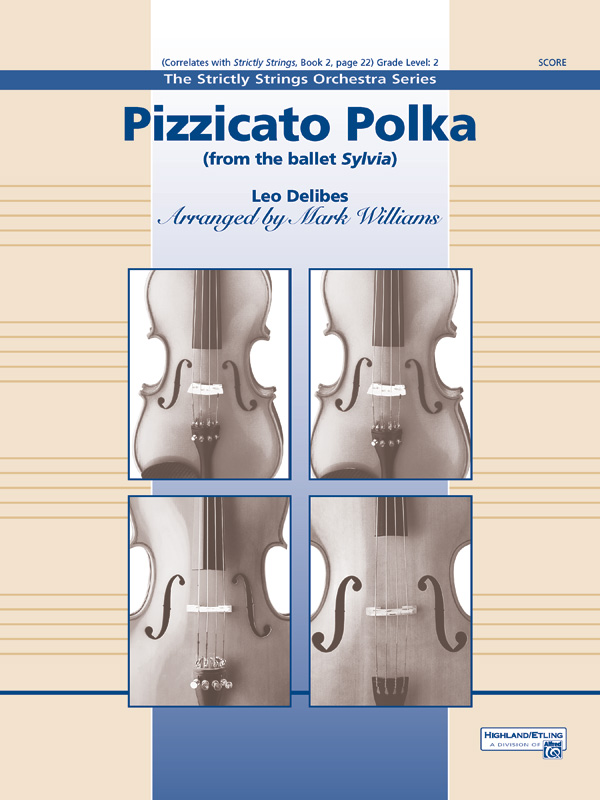

The original Pizzicato Polka for strings received no less than eight encores at its world premiere in 1869, so plucky trio bassists should take care of their pizzicato fingers. The parts are nicely spaced, so you should be able to achieve a well-balanced and effective performance. Although Recital Music also publish a version for four basses, this particular edition for bass trio has the top part going up to thumb position, and the other players firmly wihtin the orchestral tessitura. Get those plucking fingers ready! ‘This is a fine arrangement of the old Viennese chestnut.
#Pizzicato polka string orchestra series
Arranged by David Heyes for a concert series in Mallorca, it can be performed by single players or larger forces. It was the first all-pizzicato work, other notable examples being by Léo Delibes (Pizzicato Polka from ?Sylvia?) and Benjamin Britten (Playful Pizzicato from ?Simple Symphony?), and has captivated audiences for 150 years. He agreed, and just look – the polka caused a furore in the true sense of the word.? The Pizzicato Polka was first performed on 12 June 1869 and was played no less than nine times that evening. He did not want to do it – he was always indecisive – finally I proposed to him that the polka should be created by the two of us. Petersburg, and suggested he should prepare a pizzicato polka.

Petersburg engagement (I have been there 10 times and earned lots of money) – to compose something which would catch on in St. In 1892 Johann wrote about the joint collaboration of the Pizzicato Polka: ?I advised by brother Josef – so that he could secure the St. Petersburg Tsarskoye-Selo Railway Company to conduct the orchestra in Pavlosk (Russia) during the summer months.
#Pizzicato polka string orchestra full
A full return of section A and a brief coda of descending scales closes the piece.In 1869 Josef Strauss (1827-70) and his brother Johann (1825-1899), ?the Waltz King?, were invited by the St. Each melody of the B section is repeated. Broken chords played on all instruments open the contrasting tune, the second half of which consists of descending scales. The central section features the glockenspiel in the first of its two melodies, which derives its identity more from color than from melodic shape. A literal return of the first melody rounds out the A section. The second melody is quite different, with its falling scales, constant eighth note pulse and occasional rests. After a brief introduction, the first eight-measure tune falls into two sections and outlines chords with alternating eighth and sixteenth note rhythms. Possibly because of the limited instrumentation, Strauss seems to have attempted to provide as much contrast as possible in other ways, such as the rhythm and shape of melodies. As the title suggests, the entirety of the piece is scored for plucked strings, although a glockenspiel appears for the first half of the central section. Like other works on which Strauss collaborated with one or both of his brothers, the Pizzicato-Polka bears no opus number.Ĭonsisting of four melodies, the Pizzicato-Polka is arranged in ternary form. Scored for strings and glockenspiel, the polka was published in Vienna the next year and became very popular, especially in Italy, where Strauss included it on the program of every one of his tours. With his brother Josef, Johann Strauss had composed the Pizzicato-Polka in 1869 for one of his several visits to Russia. It exhibits a ternary (ABA) form with eight-measure subsections and sometimes includes an introduction and a coda. A French dictionary of dance terms dating from 1847 describes the polka as having a tempo of 104 beats per minute with an emphasis on the second beat of the measure. The polka was very popular in the late nineteenth century and examples were penned by nearly every major composer of dance music, performed by almost all military bands and distributed in the form of sheet music throughout the world.

Local musicians created variants of the dance, and in the 1850s in Vienna, the elegant Polka française and the lively Schnell-Polka developed. By 1843-1844 it was the favorite dance of Parisians and in May, 1844, it was first performed in the U.S. The dance was exported to Vienna in 1839 by a Bohemian regiment band, precipitating its rapid spread throughout Europe. Whatever its origins, it is certain that the polka first appeared in Prague in 1837. The name may be derived from the Czech pulka (half) or polska, the Czech word for a Polish girl. A couple-dance in 2/4 meter, it seems the polka developed in Bohemia as a type of round-dance with three short, heel-and-toe half-steps on the first three half-beats and a rest on the fourth.

Some of the characteristics of the polka appear in music performed by and written for Bohemian village musicians around 1800 aside from this, the dance's origins are obscure.


 0 kommentar(er)
0 kommentar(er)
